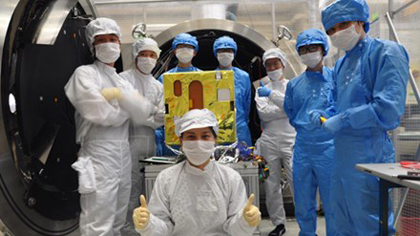Vietnam to launch remote sensing satellite in 2019
The nation is expected to rocket a radar Earth observation satellite called LOTUSat-1 in early 2019.
It will be built in Japan by NEC, with the participation of Vietnamese engineers.
Then, Vietnamese engineers should do themselves in designing and manufacturing LOTUSat-1 in 2020, making a great progress in the development of Vietnam’s space science sector.
 |
| Vietnamese and Japanese experts with MicroDragon satellite. |
On May 8th, 2013, by launching the first remote sensing satellite VNREDSat-1 (short for Vietnam Natural Resources, Environment and Disaster Monitoring Satellite) of the Vietnam Academy of Science and Technology into space, Vietnam has became one of 25 nations in the world with an optical Earth observing satellite. Its primary mission is to monitor and study the effects of climate change, predict and take measures to prevent natural disasters, and optimise the management of Vietnam's natural resources. With a five-year mission duration, the 120 kg satellite will image at 2.5 m in panchromatic mode and 10 m in multi-spectral mode (four bands) with a 17.5 km swath, and will orbit at 600-700 km in a sun synchronous orbit.
Meanwhile LOTUSat-1 weights 600kg, using advanced radar Earth observation for better captured photos. It can identify and will image objects at 1,0 m in panchromatic mode.
The two receiving stations to process captured images are being built in Hoa Lac high-tech park and Ho Chi Minh city.
Once completed, the two radar Earth observation satellites should help the nation save around USD150 million in the agricultural sector.
According to Mr Pham Anh Tuan, Head of the national satellite centre, the above-motioned radars are part of the USD600 million Vietnam National Space Centre project, the largest scale one of the nation’s technology and science sector. Fundamental knowledge on space sciences, both Bachelor and Master of Art levels, should be trained at University of Science and Technology of Hanoi, Vietnam National University-Hanoi University of Engineering and Technology, and Vietnam National University-Ho Chi Minh city International University.
Currently, 35 officers have been joining training course on space technology -science in Japan. They are directly designing, manufacturing and experimenting MicroDragon satellite under the guidance from Japanese experts. Measuring 50x50x50cm, 50kg in weight, its mission is to observe coastal lines, evaluating water quality, positioning aquatic resources, and monitoring changes to treat the nation’s aquatic production. It is planned to launch in September 2017.
In June 2006, the Prime Minister has approved “The Strategy for Research and Application of Space Technology of Vietnam until 2020” which identifies objectives, contents and solutions for space technology applications until 2020 for the social-economic development of Vietnam.
So far, Vietnam expands space technology and sciences co-operation with the US, Russia, France and Japan.
Apart from training aeronautical engineers and space technology, Vietnam is programming projects for local students.
A project on setting up the National Museum of Space Science is being carried out. Once completed in late 2017, it should cultivate the love of aeronautical and space sciences for Vietnamese students and experts.
(Source: CPV)
 về đầu trang
về đầu trang







